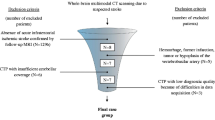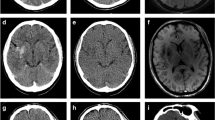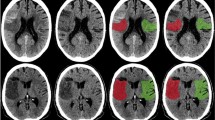Abstract
Purpose
The presence of intraparenchymal hyperattenuations (IPH) on flat-panel computed tomography (FP-CT) after endovascular recanalization in stroke patients is a common phenomenon. They are thought to occur in ischemic areas with breakdown of the blood-brain barrier but previous studies that investigated a mutual interaction are scarce. We aimed to assess the relationship of IPH localization with prethrombectomy diffusion-weighted imaging (DWI) lesions.
Methods
This retrospective multicenter study included 27 acute stroke patients who underwent DWI prior to FP-CT following mechanical thrombectomy. After software-based coregistration of DWI and FP-CT, lesion volumetry was conducted and overlapping was analyzed.
Results
Two different patterns were observed: IPH corresponding to the DWI lesion and IPH exceeding the DWI lesion. The latter showed demarcated infarction of DWI exceeding IPH at 24 h. No major hemorrhage following IPH was observed. Most IPH were manifested within the basal ganglia and insular cortex.
Conclusion
The IPH primarily appeared within the initial ischemic core and secondarily within the penumbral tissue that progressed to infarction. The IPH represent the minimum final infarct volume, which may help in periinterventional decision making.



Similar content being viewed by others

References
Psychogios MN, Buhk JH, Schramm P, Xyda A, Mohr A, Knauth M. Feasibility of angiographic CT in peri-interventional diagnostic imaging: a comparative study with multidetector CT. AJNR Am J Neuroradiol. 2010;31(7):1226–31.
Kau T, Hauser M, Obmann SM, Niedermayer M, Weber JR, Hausegger KA. Flat detector angio-CT following intra-arterial therapy of acute ischemic stroke: identification of hemorrhage and distinction from contrast accumulation due to blood-brain barrier disruption. AJNR Am J Neuroradiol. 2014;35(9):1759–64.
Arakawa H, Marks MP, Do HM, Bouley DM, Strobel N, Moore T, Fahrig R. Experimental study of intracranial hematoma detection with flat panel detector C‑arm CT. AJNR Am J Neuroradiol. 2008;29(4):766–72.
Payabvash S, Khan AA, Qureshi MH, Saeed O, Suri MF, Qureshi AI. Detection of Intraparenchymal hemorrhage after endovascular therapy in patients with acute Ischemic stroke using immediate postprocedural flat-panel computed tomography scan. J Neuroimaging. 2016;26(2):213–8.
Yilmaz U, Walter S, Korner H, Papanagiotou P, Roth C, Simgen A, Behnke S, Ragoschke-Schumm A, Fassbender K, Reith W. Peri-interventional subarachnoid hemorrhage during mechanical thrombectomy with stent retrievers in acute stroke: a retrospective case-control study. Clin Neuroradiol. 2015;25(2):173–6.
Yoon W, Jung MY, Jung SH, Park MS, Kim JT, Kang HK. Subarachnoid hemorrhage in a multimodal approach heavily weighted toward mechanical thrombectomy with solitaire stent in acute stroke. Stroke. 2013;44(2):414–9.
Parrilla G, García-Villalba B, Espinosa de Rueda M, Zamarro J, Carrión E, Hernández-Fernández F, Martín J, Hernández-Clares R, Morales A, Moreno A. Hemorrhage/contrast staining areas after mechanical intra-arterial thrombectomy in acute ischemic stroke: imaging findings and clinical significance. AJNR Am J Neuroradiol. 2012;33(9):1791–6.
Shi ZS, Liebeskind DS, Loh Y, Saver JL, Starkman S, Vespa PM, Gonzalez NR, Tateshima S, Jahan R, Feng L, Miller C, Ali LK, Ovbiagele B, Kim D, Duckwiler GR, Viñuela F; UCLA Endovascular Stroke Therapy Investigators. Predictors of subarachnoid hemorrhage in acute ischemic stroke with endovascular therapy. Stroke. 2010;41(12):2775–81.
Rouchaud A, Pistocchi S, Blanc R, Engrand N, Bartolini B, Piotin M. Predictive value of flat-panel CT for haemorrhagic transformations in patients with acute stroke treated with thrombectomy. J Neurointerv Surg. 2014;6(2):139–43.
Yoon W, Seo JJ, Kim JK, Cho KH, Park JG, Kang HK. Contrast enhancement and contrast extravasation on computed tomography after intra-arterial thrombolysis in patients with acute ischemic stroke. Stroke. 2004;35(4):876–81.
Renú A, Amaro S, Laredo C, Román LS, Llull L, Lopez A, Urra X, Blasco J, Oleaga L, Chamorro Á. Relevance of blood-brain barrier disruption after endovascular treatment of ischemic stroke: dual-energy computed tomographic study. Stroke. 2015;46(3):673–9.
Antonucci MU, Mocco J, Bennett JA. New insight into transient contrast enhancement on computed tomography after endovascular treatment of stroke. Interv Neuroradiol. 2012;18(3):303–8.
Nakano S, Iseda T, Kawano H, Yoneyama T, Ikeda T, Wakisaka S. Parenchymal hyperdensity on computed tomography after intra-arterial reperfusion therapy for acute middle cerebral artery occlusion: incidence and clinical significance. Stroke. 2001;32(9):2042–8.
Schaefer PW, Grant PE, Gonzalez RG. Diffusion-weighted MR imaging of the brain. Radiology. 2000;217(2):331–45.
Yang Y, Rosenberg GA. Blood-brain barrier breakdown in acute and chronic cerebrovascular disease. Stroke. 2011;42(11):3323–8.
Amans MR, Cooke DL, Vella M, Dowd CF, Halbach VV, Higashida RT, Hetts SW. Contrast staining on CT after DSA in ischemic stroke patients progresses to infarction and rarely hemorrhages. Interv Neuroradiol. 2014;20(1):106–15.
Lummel N, Schulte-Altedorneburg G, Bernau C, Pfefferkorn T, Patzig M, Janssen H, Opherk C, Brückmann H, Linn J. Hyperattenuated intracerebral lesions after mechanical recanalization in acute stroke. AJNR Am J Neuroradiol. 2014;35(2):345–51.
Ghobrial GM, Nair AK, Dalyai RT, Jabbour P, Tjoumakaris SI, Dumont AS, Rosenwasser RH, Gonzalez LF. Contrast stasis on noncontrast computed tomography as a predictor of stroke postthrombolysis. Neurosurg Focus. 2011;30(6):E13.
Kim JT, Heo SH, Cho BH, Choi SM, Lee SH, Park MS, Yoon W, Cho KH. Hyperdensity on non-contrast CT immediately after intra-arterial revascularization. J Neurol. 2012;259(5):936–43.
Türe U, Yaşargil MG, Al-Mefty O, Yaşargil DC. Arteries of the insula. J Neurosurg. 2000;92(4):676–87.
Cheng B, Golsari A, Fiehler J, Rosenkranz M, Gerloff C, Thomalla G. Dynamics of regional distribution of ischemic lesions in middle cerebral artery trunk occlusion relates to collateral circulation. J Cereb Blood Flow Metab. 2011;31(1):36–40.
Marcoux FW, Morawetz RB, Crowell RM, DeGirolami U, Halsey JH Jr.. Differential regional vulnerability in transient focal cerebral ischemia. Stroke. 1982;13(3):339–46.
Koga M, Reutens DC, Wright P, Phan T, Markus R, Pedreira B, Fitt G, Lim I, Donnan GA. The existence and evolution of diffusion-perfusion mismatched tissue in white and gray matter after acute stroke. Stroke. 2005;36(10):2132–7.
Falcao AL, Reutens DC, Markus R, Koga M, Read SJ, Tochon-Danguy H, Sachinidis J, Howells DW, Donnan GA. The resistance to ischemia of white and gray matter after stroke. Ann Neurol. 2004;56(5):695–701.
Goldberg MP, Ransom BR. New light on white matter. Stroke. 2003;34(2):330–2.
Author information
Authors and Affiliations
Corresponding author
Ethics declarations
Conflict of interests
A. Frölich received speaker fees from Siemens Healthcare Forchheim, Germany. M. Wagner declares that there is a permanent scientific cooperation between Siemens Healthcare AG and the Institute of Neuroradiology of the University Hospital Frankfurt. C. Cognard is consultant/proctor for Stryker, Medtronic, Sequent, Microvention and Codman. A. Bonafé is consultant for Covidien and Stryker. J. Fiehler received lecture or consultancy fees from Acandis, MicroVention, Stryker, Sequent Medical, Codman, Boehringer Ingelheim, Covidien, Philips Healthcare, Siemens Healthcare and Penumbra. J.-H. Buhk received lecture or consultancy fees from Acandis, MicroVention, Stryker, Sequent Medical, Codman and Philips Healthcare. T. Schneider, T. Mahraun, J. Schroeder, P. Hoelter, J. Darcourt and S. Siemonsen declare that they have no conflict of interests.
Ethical standards
All studies on humans described in the present manuscript were carried out with the approval of the responsible ethics committee and in accordance with national law and the Helsinki Declaration of 1975 (in its current, revised form). Informed consent was obtained from all patients included in studies.
Additional information
T. Schneider and T. Mahraun are joint first authors.
Rights and permissions
About this article
Cite this article
Schneider, T., Mahraun, T., Schroeder, J. et al. Intraparenchymal Hyperattenuations on Flat-Panel CT Directly After Mechanical Thrombectomy are Restricted to the Initial Infarct Core on Diffusion-Weighted Imaging. Clin Neuroradiol 28, 91–97 (2018). https://doi.org/10.1007/s00062-016-0543-y
Received:
Accepted:
Published:
Issue Date:
DOI: https://doi.org/10.1007/s00062-016-0543-y



